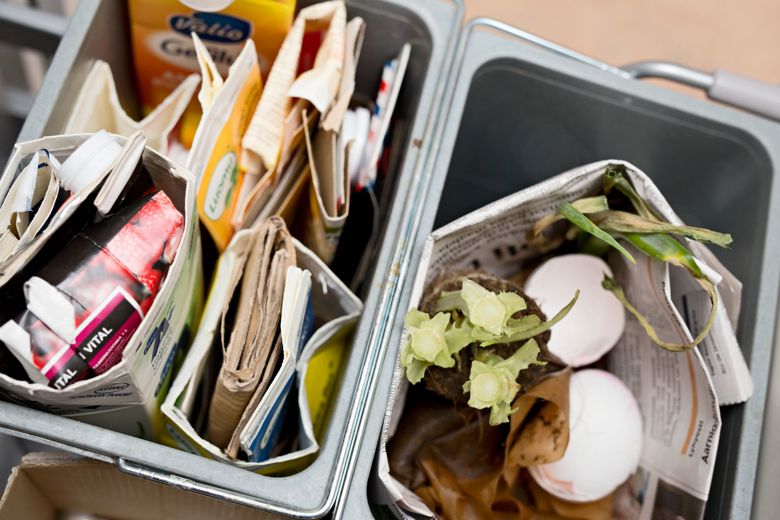Waste statistics and recycling rates

Amount of waste
The Helsinki Metropolitan region and Kirkkonummi generated 318 700 tonnes of house hold waste in the year 2024. This is 244 kg per capita, which is 1 kg more than the previos year.
Municipal solid waste (MSW) generated at the Helsinki Metropolitan region and Kirkkonummi amounted to 655 000 tonnes in the year 2024. This is 500 kg per capita. MSW consists of household waste and similar waste from the service sector.
According to statistics, the amount of MSW is decreasing back to the same level as it was in during the COVID-19 pandemic. This is especially true with the waste produced by the private services compared to years 2022 and 2023. The waste amount from public services has remained at the same level as in 2023. However, the amount of household waste has increased slightly, which is probably due to change in consumption habits.
Municipal household waste statistics
In 2024, household waste volumes and recycling rates were calculated by municipality for the fourth time. Data by municipality could be separated for waste types collected by HSY, taking into account the locations of properties, regional collection points, and Sortti stations. However, some source data—such as paper and electrical and electronic waste (WEEE)—was estimated from national data based on population.
| City specific household waste statistics | ||||||
| Region | Helsinki | Espoo | Vantaa | Kauniainen | Kirkkonummi | |
| kg per capita | 244 | 242 | 227 | 259 | 270 | 310 |
| change of kg per capita | +1 | -2 | 0 | +3 | -4 | +4 |
| recycling rate | 45% | 45% | 46% | 42% | 47% | 41% |
| change of recycling rate | -1% | -1% | -2% | -1% | -3% | -2% |
Other waste
Every two years, in addition to household and municipal waste, we also compile statistics on other waste generated in the region. These figures involve greater uncertainty and variability, but over the long term they show trends. In 2024, the largest share—about 66%—of all waste generated in the Helsinki metropolitan area and Kirkkonummi consisted of soil masses from earthworks and water construction. These statistics do not include masses that were directly reused. The remaining waste was distributed by sector as follows: household waste 8%, building construction waste 6%, private service sector 6%, energy and water sector 6%, industry 3%, public service sector 3%, and wastewater management 2%.
The chart below allows to view waste volumes by waste category (municipal waste, other waste) and by sector. Municipal waste is divided into three sectors: households, public services, and private services. Other waste is divided into five sectors: energy and water, infrastructure construction, housing construction, industry, and wastewater management. Units can be shown either as tonnes per year or kilograms per capita per year.
Municipal solid waste by sector
Recycling rate
In 2024, 45% of household waste in the Helsinki metropolitan area and Kirkkonummi was recycled, and the rest was used for energy recovery. Household waste is no longer sent to landfill without recovery. When calculating the recycling rate, amounts removed during the recycling process (rejects) are taken into account—so the figure includes only truly recycled material. The goal is to increase recycling even further. This can be achieved by improving sorting and reducing the amount of mixed waste used for energy recovery.
The recycling rate for municipal waste in 2024 was about 47%. Separate collection of biowaste from private services helps raise the rate, while the permanent decline in collected paper due to digitalization lowers it.
The chart below shows municipal waste volumes by recovery method, with units selectable as tonnes per year or kilograms per capita per year.
Municipal solid waste utilization
Type of waste
In households, about 50% of generated waste is mixed waste—around 122 kilograms per person. A large share of this could actually be sorted. The greatest potential for improvement is in biowaste sorting. Most separately collected waste ends up being recycled. Mixed waste and wood are mainly used for energy recovery, and hazardous waste is disposed of in specialized incineration plants where heat is recovered.
The chart below shows municipal waste volumes by sector (households, public services, private services) and by waste type (mixed waste and separately collected types). Units can be shown either as tonnes per year or kilograms per capita per year.
Municipal solid waste by waste type
Household mixed waste composition
A household mixed waste composition study in the Helsinki metropolitan area is carried out every three years. The results are published as open data (in Finnish).
The single largest waste fraction in household mixed waste is biowaste. When soft paper is included in biowaste, it accounts for 33% of mixed waste in 2024. Over 70% of household mixed waste could have been sorted for recycling.
Household mixed waste composition
